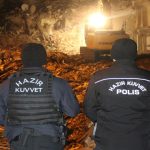It has been two months since the earthquake described as the “disaster of the century” hit Turkey’s provinces in the southeast, killing more than 50,000. Now, the rubble left behind may cause the environmental disaster of the century. According to the United Nations Development Program (UNDP), “the earthquake generated between 116 million and 210 million tons of rubble,” which is more than any disaster in recent history. “The volume outpaces debris from Hurricanes Katrina (76 million cubic meters of debris), Sandy (11 million), and Harvey (9 million), according to government estimates of those storms,” reported the Washington Post. The authorities have been quick to start cleaning the debris from collapsed buildings and roads.
But officials are facing challenges over where to dump the waste and rubble from the destroyed buildings and roads and how to dispose of it. Weeks after the earthquake, Eyüp Karahan, General Manager of Environmental Management at the Ministry of Environment, Urbanization and Climate Change (CSB), said the work was being carried out so as to cause the least damage to the environment. But local reports and evaluations from experts say otherwise.
On February 15, reports of the debris being dumped at the Milleyha Bird Sanctuary in Hatay — one of the worst-hit provinces — alarmed conservationists and environmentalists. It was bird watcher Emin Yoğurtcuoğlu who tweeted about the dump. Yoğurtcuoğlu’s tweet caused an uproar, and the rubble was eventually removed.
Responding to Yoğurtcuoğlu’s tweet, Emin Birpınar, Deputy Minister of CSB said the municipalities were warned and thanked environmentalists for alerting them of the incorrect disposal. Birpınar also promised there would be no more waste dumping in the protected area.
However, environmentalists are also concerned about how waste is being collected and transported. According to this report, rows of trucks were spotted in Antakya, another province hit by the earthquake, transporting the debris uncovered, increasing the chances of potentially spreading harmful and contaminated waste, further endangering human lives and the environment. According to plastic pollution expert Sedat Gündoğdu, who spoke to France 24, “[this waste] can contain many different chemicals like lead or microplastics or asbestos.”

Screenshot from a video report by DHA from Hatay.
In Karahan’s earlier statement, he said debris dump areas were identified with the help of local governorships. “We determined the areas that do not harm the nature and the environment” and that the state was following a debris management plan that involves the careful removal of waste, disposal, recycling, and other measures. But according to Pinar Keskinocak, a professor of industrial and systems engineering at Georgia Tech, and co-founder and director of the Center for Health and Humanitarian Systems, debris management requires the involvement of multiple stakeholders, including experts in “geology, civil and environmental engineering, city and regional planning, public health, industrial and systems engineering.” In addition to the involvement of various actors, there must also be “oversight to ensure that the plans are carried out properly or revised as needed.”
The current assessment indicates Turkey “does not have the capacity to manage the amount of waste,” that has been created as a result of the earthquake, according to Gündoğdu.
A number of representatives of trade associations told DW they were not being consulted on disposal procedures, despite their expertise in the field.
In a Twitter thread, Yasin İlemin from Muğla Sıtkı Koçman University, explained in detail the consequences of uncontrolled and unchecked waste dumping. Unless disposed of properly, the debris could endanger the lives of thousands more — and it won’t be just human lives in danger but natural habitats too, explained Ilemin:
If the existing excavations are poured into the valley plains, natural wetlands and agricultural areas in the natural areas during the pre-construction preparation stage, a great danger will begin in the region. First of all, these harmful substances will be mixed with the soil and groundwater. This will eventually lead to an array of diseases, especially cancer among people, consuming the food grown in these (contaminated) agricultural areas. In addition to the region being an agricultural paradise, it is also home to unique biodiversity.
Aware of all the potential dangers and consequences of uncontrolled, unchecked waste dumps, scientists like Ilemin warn that when choosing areas to dispose of the waste, it is important to do so “far from protected areas, wetlands, and wildlife areas,” and that “it is necessary to choose impermeable floors and to avoid contact with underground and surface waters.”
The warnings have not made a difference. What happened at the Milleyha Bird Sanctuary was just one example. Elsewhere in places like Samandağ, a district in Hatay, local residents affected by the earthquake and who have been resettled in tents have been protesting the waste dump next to their settlements.
The earthquake area is in grave condition but there are no TV cameras filming or channels showing. Why? Residents of Samandag are watching the waste being dumped next to their tent settlements. “The government will remain under the rubble”
According to Bianet, at least 15 earthquake survivors were detained by the local police on April 4 while protesting at a debris dump.
In another report, debris was seen dumped into a creek in another village in Hatay. In Kahramanmaraş the Union of Chambers of Turkish Engineers and Architects discovered the debris was dumped in the Aksu Basin and Sır Dam. In Adıyaman, experts from the Gaziantep Chamber of Environmental Engineers discovered that the debris had been dumped at two locations that were not suitable. When the chamber representatives raised the issue with the authorities, they were told these were temporary and that the local military police were in charge of security.
According to state regulations, it is forbidden to dump construction and demolition waste into seas, lakes, streams, or anywhere other than recycling and storage facilities. According to AFAD’s Disaster Response Plan, debris removal includes: identifying debris dump areas; ensuring the removal of the debris once search and rescue operations are complete; removing the debris; and demolishing damaged buildings.
In an interview with DW, Gürkan Akgün, the Head of the Department of Reconstruction and Urbanization at Istanbul Municipality said, “Removing the debris quickly can lead to additional problems,” the priority is in identifying appropriate storage areas and involving experts in the process. Others have pointed to other major earthquakes, such as the one in Kobe or Great Hanshin, Japan, in 1995, and the time it took to carefully dispose of the waste. “It took 4 years to remove 15 million tons of debris from the buildings destroyed,” wrote prominent environmental and human rights activist Bülent Şık in a Twitter thread on April 2. In post-earthquake Turkey, “The lack of method and speed of debris removal by the political power will cause serious problems over time,” he added, highlighting the need for first collect toxic materials, before disposing of the remaining debris, “in a way that does not cause environmental pollution.”
The Turkish state was subject to scrutiny and criticism over its delayed response when the earthquake hit on February 6. In the course of the coming days and weeks, more criticism was leveled against the state for its continuing lack of coordination. Now, two months later, the shortcomings documented by experts and journalists in post-earthquake provinces point to the same challenges. Meanwhile, President Erdoğan is determined to secure another term in the upcoming election, scheduled for May 14. In a bid to gather support, he was seen throwing toys and handing out money to children in earthquake-hit areas last month. The images reminded Turks of the president throwing bags of tea to victims as he visited areas affected by the forest fires in the summer of 2021. Back then, authorities downplayed the scale of the damages caused by the fire, something they cannot do after the most recent earthquake.
By: Arzu Geybullayeva
Source: Global Voices



